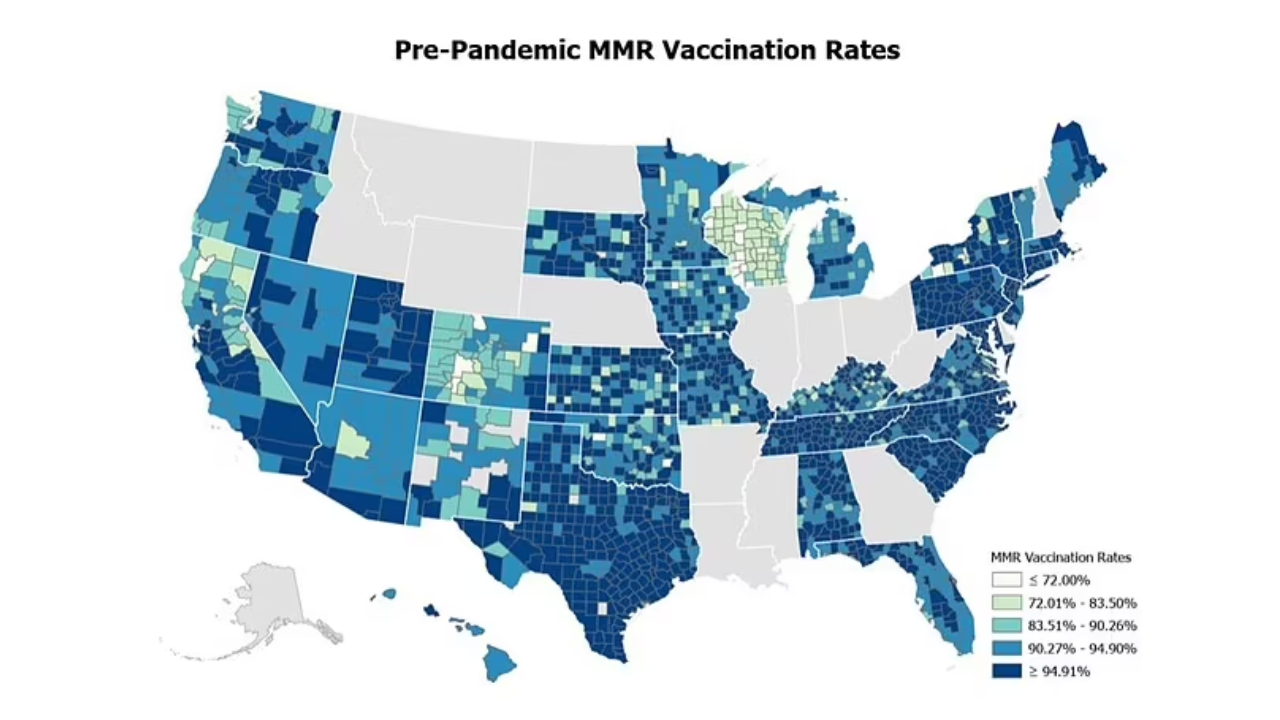- Health Conditions A-Z
- Health & Wellness
- Nutrition
- Fitness
- Health News
- Ayurveda
- Videos
- Medicine A-Z
- Parenting
- Web Stories
As Measles Cases Rise, Kennedy Calls Vaccination 'A Personal Choice'- Which US States Have The Lowest Immunization Rates?

The continuous surge in measles cases in the United States has sent shockwaves throughout the public health community, with Texas experiencing its largest outbreak in thirty years- close to 150 cases, the highly infectious virus has caused at least 20 hospitalizations and one reported death. The outbreak highlights the ongoing decline of MMR (measles, mumps, and rubella) vaccine coverage, fueling new debate regarding the importance of immunization.
Amidst this crisis, U.S. Health and Human Services Secretary Robert F. Kennedy Jr. while addressing the issue, emphasized that vaccination is a "personal choice." His words, which appeared in an opinion column, recognize the value of community immunity but fall short of calling for the vaccine. Rather, Kennedy urged parents to consult with healthcare providers and make informed choices about immunization.
Declining in MMR Vaccination Rates Causing the Rise in Cases
For four straight years, the U.S. has dipped below the 95% vaccination level advised by health officials to avert measles outbreaks. Based on the most recent data provided by the Centers for Disease Control and Prevention (CDC), the national vaccination level of kindergartners for the 2023-2024 school year declined to 92.7%. At the same time, the number of kindergartners obtaining exemptions from at least one vaccine among the ones required reached a record 3.3%.
This declining trend is worrying for public health authorities, as measles, which had been declared eliminated in the United States, is on the comeback trail because of declining vaccine coverage. The most effective preventive agent is still the MMR vaccine, with 97% immunity after two doses. Misinformation, vaccine resistance, and individual exemption policies, however, have resulted in lower rates of immunization in various states.
How Did Measles Turn Into A Dangerous Disease?
Measles is among the most infectious viral infections, spreading via airborne droplets of cough and sneeze. Its symptoms are fever, cough, rhinorrhea, and the red rash characteristic of measles. It can in extreme cases develop into pneumonia, encephalitis, and even death, particularly among children under five and immunocompromised persons.
Although severe, there is no antiviral medication for measles. The best and only sure method is still vaccination, not just for individual protection but also to promote herd immunity, which protects those with medical conditions and are therefore not eligible for the vaccine. MMR vaccination remains the best measure against outbreaks as promoted by the CDC and local health authorities.
The current measles outbreak has heightened the national controversy over vaccine mandates and personal freedoms. Kennedy's words capture the wider controversy, weighing individual freedoms against public health interests. In conceding the vaccine's efficacy in preventing measles, he emphasizes the need to present accurate information and respond to community concerns through education and access.
Kennedy's previous comments on vaccines have not been well-received by medical professionals, as he has previously raised questions regarding vaccine safety. Various studies have dispelled any correlation between the MMR vaccine and autism, reaffirming its safety and efficacy. Despite this, growing vaccine hesitancy has spurred decreasing immunization rates, especially in states with relaxed exemption laws.
Which U.S. States Have the Lowest MMR Vaccination Rates?
The CDC has listed a number of states where MMR vaccination coverage in kindergartners remains disconcertingly low. These states are most susceptible to measles outbreaks because of their low herd immunity:
Idaho: 79.6%
Alaska: 84.3%
Wisconsin: 84.8%
Minnesota: 87%
Florida: 88.1%
Colorado: 88.3% (tie)
Oklahoma: 88.3% (tie)
Georgia: 88.4%
Utah: 88.8%
Iowa: 89.1%
States such as West Virginia have the highest MMR coverage, with 98.3% of kindergartners being vaccinated.
As measles cases rise, U.S. faces a critical moment in public health. The decline MMR vaccination rates poses a severe risk to community immunity, and more outbreaks are likely. Although Kennedy's focus on individual choice strikes a chord in some, medical professionals across the board agree that mass immunization is the greatest defense against measles.
Fish Skin Grafts Saves Infant From Life Threatening Wound

(Credit-Canva)
Traditionally and otherwise too, what is usually used to treat open wounds, fish skin grafts have gained a lot of popularity in the research and medicine community. Research, like the study from 2023, published in the journal Cureus, showed that using fish skin graft helped wounds heal faster and reduce pain. Not only is it readily available, but it is also inexpensive to produce. The Nature, scientific reports explained that the highly porous nature of the fish skin is well suited to support cell ingrowth. While it has been used many times for different types of medical emergencies, the use of it on newborns had not been considered until this case.
Born premature at just 23 weeks and weighing only one pound, Eliana DeVos faced immense challenges from the beginning. Speaking to the CNN News, Eliana’s mom, Krystal DeVos, explained that Eliana had spent 131 days in neonatal intensive care, where she developed a severe, rapidly spreading infection on her neck. Her mom described it as "almost like a flesh-eating disease" that nearly claimed her life, leading to dangerous sepsis. As Eliana's condition deteriorated, her family and doctors desperately sought a solution.
An Unconventional Treatment
The treatment option the doctor chose, although unconventional, had a lot of hope. Doctors chose to use fish skin to heal her wound. The pediatric plastic surgeon, explained that Eliana was too fragile for traditional surgery or a human skin graft due to her prematurity and the extensive wound.
Instead, the doctor and the wound care nurse opted for a medical honey solution to clean the wound, followed by the application of medical-grade fish skin. This product, made from wild North Atlantic cod by the Icelandic company Kerecis, acts as a scaffold for new skin tissue to grow. Its structure is remarkably similar to human skin, and it's rich in omega oils and other natural healing elements. The remarkable thing about this fish skin graft
How Does A Fish Skin Graft Work?
Doctors believe Eliana was likely the first preemie of her size to receive this innovative treatment. While fish skin has been used globally for wound care, its application in children, particularly infants as tiny as Eliana, is uncommon.
Doctors highlighted that other animal tissues, known as xenografts, which are from animals like pigs or cows, are also used for wound healing. These don't replace skin but serve as temporary dressings to promote cleanliness and initiate healing. However, experts cautioned that not all wounds respond to these methods.
A significant concern with such treatments, especially in infants, is the potential for unknown allergies, particularly to fish. The biggest risk the doctors were worried about was the unknown allergy risk. If the baby had a fish allergy, it could’ve made things a lot more difficult. They also noted that even with these treatments, there's still a possibility that surgery might be necessary.
Recovery and Recuperation For the Infant
For Eliana's mom, the experience has been incredibly inspiring. She hopes people will recognize the immense value of modern medicine and the power of faith. She explained how immensely worried she was, however, it never stopped her from trying something new. She encourages people to try something new and be open-minded.
Against Medical Evidence, Louisiana Lawmakers Deny Abortion Access To Rape Victims

Credits: Canva
For the third consecutive year, Louisiana lawmakers have rejected a bill that would have allowed abortion access to minors who become pregnant as a result of rape. The proposed legislation, authored by Democratic Representative Delisha Boyd, sought to expand the state’s near-total abortion ban by permitting exceptions for girls under the age of 17 who are victims of sexual assault.
In an emotionally charged legislative committee meeting on Tuesday, several lawmakers cited their religious beliefs as the reason for voting against the measure. Despite impassioned pleas from supporters of the bill, it failed in a 3-9 vote, with two Democrats joining Republicans in opposition.
A Deeply Personal and Painful Debate
Both Boyd and fellow Democratic Representative Patricia Moore have personal ties to the issue—they were born after their mothers were raped as teenagers. Boyd, born in 1969, just four years before Roe v. Wade legalized abortion nationwide, emphasized that her mother did not have a choice. “I know the Bible. But I also know God gives people the ability to do right and wrong,” she said during the hearing.
Moore, who represents a deeply religious constituency, expressed her inner turmoil over the bill. “I’m struggling because life and death, according to our Heavenly Father, it’s in His hands,” she said. Moore shared the tragic example of a pregnant nine-year-old girl in her district, adding to the gravity of the debate. Yet, she concluded that she could not support the bill, citing her faith and belief in divine purpose: “God would take a bad situation and turn it into good.”
Abortion Laws in Louisiana: A National Outlier
Louisiana has one of the strictest abortion bans in the United States. The law, triggered in 2022 after the Supreme Court overturned Roe v. Wade, prohibits abortion at all stages of pregnancy. The only exceptions are when the mother’s life is at substantial risk or in cases of “medically futile” pregnancies—where the fetus has no chance of survival outside the womb.
The proposed rape exception would have added a critical layer of compassion for minors suffering extreme trauma. Advocates argue that forcing young rape survivors to carry pregnancies to term not only inflicts further psychological harm but also endangers their physical health. Louisiana, notably, has one of the highest maternal mortality rates in the country, making forced pregnancies even more dangerous for young girls.
Why It Matters: The Health and Rights of Survivors
The rejection of the bill in Louisiana is part of a broader trend seen in several Republican-led states that have enacted strict abortion bans with few or no exceptions. According to a study published in the Journal of the American Medical Association, between July 2022 and January 2024, more than 64,000 pregnancies resulted from rape in states where abortion is mostly or completely banned.
Of the 12 U.S. states enforcing total abortion bans, only four currently allow exceptions in cases of rape. Louisiana is not among them. This places an immense burden on victims, especially minors, who must either carry an unwanted pregnancy to term or travel across state lines to access care—an option not available to all due to financial, logistical, or legal barriers.
A 2019 Study titled They Are Girls, Not Mothers: The Violence of Forcing Motherhood on Young Girls in Latin America, published in Health and Human Rights Journal while looks specifically at the Latin America population, it does note for the risk it presents for the young pregnant girl, physically and mentally. The study also cites the Stolen Lives report, published by Planned Parenthood Global, it notes of the severe impact that forced motherhood and pregnancies have on women. The report also speaks to the experience of 2 million girls under 15 worldwide, who are compelled to give birth every year as a result of sexual violence.
"There are severe physical, mental, and social health impacts of forced pregnancies and motherhood," notes the study.
Physical Consequences
Research has consistently shown that forced pregnancy carries severe health risks for young girls. Among the most serious physical complications are preeclampsia and preterm labor. The danger is especially high for adolescent girls—studies show that the risk of dying during childbirth is four times greater for girls than for adult women. In fact, pregnancy and childbirth are the leading causes of death for girls aged 15 to 19 worldwide.
There are also less-documented harms. Survivors of sexual violence, particularly young girls, often face obstetric violence and mistreatment in medical settings. Healthcare providers may deny them the specialized reproductive care they need or treat them with insensitivity, ignoring the trauma and vulnerability of their situation.
In countries like Guatemala and Nicaragua, Caesarean sections have become common for adolescent pregnancies—not due to medical necessity, but because of a lack of training among medical professionals to support the specific needs of young survivors of sexual violence. These early surgeries can have long-term consequences, including surgical complications and the risk of adhesions later in life.
Psychological and Emotional Toll
The mental health impact of forced motherhood is equally severe. Feelings of anxiety, depression, fear, and hopelessness are common. Investigations by Planned Parenthood Global have linked such pregnancies to suicidal ideation and attempts, especially in places where reproductive choices are heavily restricted.
A 2019 report titled Silenced Lives found that in Alta Verapaz, Guatemala, 50% of the teenage girls who died by suicide in 2017 were pregnant. One such girl, Juana, became severely depressed after her pregnancy. In her own words: “I want to die; my heart is not happy like before.”
Social Impact
Forced motherhood drastically reshapes the social trajectory of young girls. According to the Stolen Lives report, teenage pregnancy often leads to girls dropping out of school, missing employment opportunities, and falling into cycles of poverty and dependence. Many never return to education and become stuck in low-wage jobs, prolonged unemployment, or abusive relationships.
- Teen mothers are statistically more likely to:
- Not complete high school
- Work in low-income or unstable jobs
- Depend on welfare
- Become single parents
- Live in poverty long-term
In the study spanning four countries, 33% of the girls had only attended primary school. Without education or income, these girls lose not only their future prospects but also their sense of belonging. They are often removed from school and peer groups, isolated from community life, and pushed into adult roles they are unprepared for.
Pregnancy at such a young age reinforces harmful cultural stereotypes about gender, sexuality, and power. Girls like Juana, who wished to finish school, often end up in government shelters until they reach legal adulthood, stripped of autonomy and burdened with responsibilities well before their time.
The Path Forward: Choice, Compassion, and Health
Supporters of the bill argue that being pro-life should also mean valuing the lives and mental well-being of children who are victims of sexual assault. As Boyd said, “We should also be fighting for the life of those children who are raped and molested.”
While the measure failed again this year, the growing body of evidence and rising national awareness about the consequences of such bans suggest that the debate is far from over. For now, young rape survivors in Louisiana will continue to face some of the harshest abortion restrictions in the nation—caught at the intersection of trauma, law, and faith.
Measles Vaccination Rates Fall In US, Map Reveals Counties At High Risk For Outbreaks

Credits: iStock
A sudden decline in U.S. childhood MMR vaccination rates has left millions of children at increased risk for measles, mumps, and rubella, a new Johns Hopkins-led study released today in JAMA reveals. With over 1,000 cases of measles and at least three reported deaths this year—numbers not seen in decades public health officials fear the country is careening toward losing its hard-won herd immunity, reactivating once-eradicated illness in communities where vaccine coverage has collapsed in the post-pandemic period.
The nationwide average kindergartener MMR vaccination rate has fallen from 93.9% prior to the pandemic to 91.2% in 2024—a decline of 2.7 percentage points. This might seem marginal, but it puts the nation perilously short of the 95% level required for herd immunity—the point at which community immunity can stop widespread measles outbreaks.
This is the first large-scale analysis to compare county-level vaccination coverage across so broad a representation of the U.S. population. The researchers analyzed data from 2,066 counties in 38 states and specifically targeted children aged five—by which age both doses of the MMR vaccine should have been given.
The new publicly released dataset—developed by the same team that created the world-renowned Johns Hopkins COVID-19 dashboard—is also giving a detailed snapshot of vaccination levels. The data is crucial to pinpointing counties that are at high risk for outbreaks in the future, particularly as measles cases also start increasing across the country.
Just four states- California, Connecticut, Maine, and New York, experienced MMR increases. The others saw decreases, with Wisconsin recording some of the lowest county-level rates of coverage.

Measles had been eliminated in the U.S. in 2000. Flash-forward 25 years, and the landscape has completely changed. In the first half of 2025 alone, more than 1,000 measles cases were confirmed in 31 jurisdictions and states, with three deaths—the first measles deaths in a decade. The CDC says that 97% of those infected had not had even one dose of the MMR vaccine.
The ongoing outbreak is localized in Texas but extends to large metropolitan and rural counties equally, reaching states like California, Florida, Illinois, and Pennsylvania. The experts are cautioning that the situation will become endemic if the vaccination levels keep declining.
The decline in MMR vaccine uptake coincides with the explosive rise of anti-vaccine misinformation, much of which is promoted by social media sites. A study conducted by Columbia University revealed that disinformation is propagated online more quickly than evidence-based interventions can combat it.
Robert F. Kennedy Jr., currently U.S. Health and Human Services Secretary, has long been involved with the anti-vaccination movement. Even in public office, Kennedy has made public claims about the uselessness of the MMR vaccine and held out pseudoscientific alternatives such as Vitamin A or "natural immunity," assertions refuted by the broader scientific community.
Fueling the flames, Texas lawmakers just signed into law a bill that will make it easier for parents to get kids into school without current MMR or other child immunizations. Exemption requests in Texas alone have increased more than doubled since 2018—from 45,900 to over 93,000 in 2024.
Understanding Herd Immunity and Measles Transmission
Measles is frequently quoted as the most infectious virus that has been known to humans. It is estimated by the CDC that 90% of exposed non-immune persons will be infected. Even more worrisome, the virus can remain airborne for two hours after an infected individual leaves a room, thus public places such as schools and clinics are extremely susceptible.
The MMR vaccine has a success rate of 97% when given two doses, the first at 12-15 months and the second at 4-6 years old. Exposure to other countries or to the community may require early vaccination in infants as young as six months.
95% or better vaccine rate guarantees that outbreaks are not viable, safeguarding those individuals who are at risk and cannot be vaccinated because of medical issues or age. With 91.2%, the U.S. is now perilously short of that mark.
Is US Repeating 2019 or 1990?
The U.S. is currently seeing the most cases of measles in one year since 2019, when there were 1,274. Before that, 1990 stands as the worst year ever, with more than 27,000 cases. The trend is unmistakable—whenever vaccination levels decline, measles comes back with a vengeance and speed.
This year's epidemic, omitting 2019, is the largest in more than 30 years. Disturbingly, the majority of cases are occurring among unvaccinated children, so the disease is not only preventable but simply unnecessary.
Professor Gardner emphasizes the urgency, "This isn't just about data—it's about our collective health. Every percentage point we lose puts thousands of children at risk."
While this research is based in the U.S., its implications are worldwide. Vaccine reluctance, partisan politics, and misinformation are not issues exclusive to America. Countries all over Europe, Asia, and Africa are observing similar declines in routine vaccination after COVID. The U.S. data provides a key guide to prevention, readiness, and policy change globally.
© 2024 Bennett, Coleman & Company Limited

